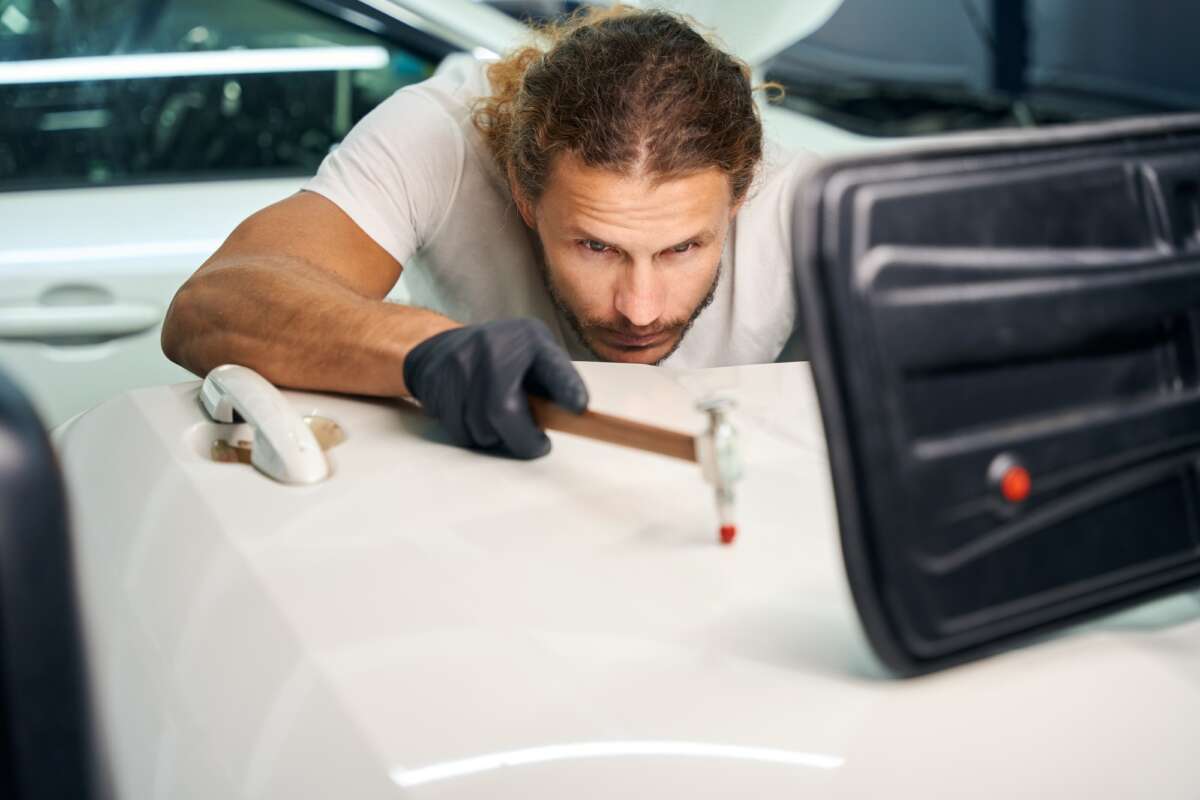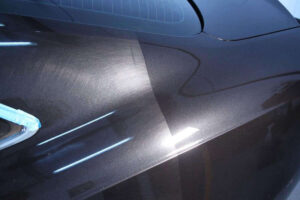What Can and Can’t Be Fixed With Paintless Dent Repair
Paintless dent repair (PDR) is a smart way to fix your car’s look. It doesn’t need costly repainting or fillers. By using special tools, it pulls out small dents and dings from behind a panel. This makes the damaged spot look like new. PDR works great on dents from hail, parking lot accidents, minor collisions, or road debris.1
But, PDR has limits too. It won’t repair dents with creases, big damage, cracked or chipped paint, or structural damage. Knowing what PDR can do helps you choose the right fix for your car.2
Key Takeaways
- Paintless dent repair can fix shallow dents up to a few inches in diameter without affecting the paint job.1
- PDR is a cost-effective solution, costing 80% less than traditional body shop repairs.1
- PDR can remove 80-90% of dents, making it an effective method for dent removal.3
- PDR works best for minor dents and dings where the paint remains intact.2
- Deeper dents, cracked or chipped paint, and structural damage may exceed the capabilities of PDR.3,2
Understanding Paintless Dent Repair (PDR)
Paintless dent repair (PDR) is a technique by auto body technicians to fix minor dents and dings. They fix these without harming the car’s paint. They use metal rods and body picks to push the dent back out from underneath. This process brings the area back to the original surface height.
Afterward, they check the repair with special lights and reflecting boards. This ensures a smooth surface along with the bodyline.
How Does Paintless Dent Repair Work?
Paintless dent repair lets technicians reach under the panel to fix the dent. They do this by pushing out the dent with special tools. This method keeps the original paint intact, saving the cost of a new paint job or using filler.
By shaping the metal back carefully, the dent gets fixed without anyone noticing. It’s a seamless repair.
Benefits of Paintless Dent Repair
Paintless dent repair has several benefits over other methods. It costs much less, saving you money.1 Also, it’s quicker than filling and painting, perfect for minor collisions or bumped car doors.
Using PDR keeps your car looking new, protecting its value. This method is convenient and affordable, especially for hail damage or small dents.
Dents That Can Be Fixed With Paintless Dent Repair
Have a dent from hail, a parking lot hit, or a small bump? Paintless Dent Repair (PDR) might be able to fix it.3 This method can take out 80-90% of a dent,3 and most fixes are done in a day or less.3
Hail Damage
If your car’s got dents from hail, PDR could be the fix.3 It’s perfect for making your car look new without paint or fillers.3
Parking Lot Dings and Dents
Do you have door dings or minor dents in your car? PDR can help, if the paint’s not cracked and it’s not too severe.3 About 44% of drivers have had this kind of damage.4 PDR is a budget-friendly choice for these issues.4
Minor Collision Damage
Small dents from accidents can often be fixed with PDR.3 Cars with more flexible paint can withstand deeper dents without paint damage.3 It’s also great for fixing dents from playing sports.3
Dents from Road Debris
Shallow dents are usually easy to fix with PDR.3 But, deeper dents from things hitting the car fast might need more work.4 Dents caused by a strong hit need careful work with PDR.4
PDR works well for many dings and dents, keeping the original paint intact.345
What Can and Can’t Be Fixed With Paintless Dent Repair
Paintless dent repair, or PDR, can fix a lot of issues like dent complexity and dent creasing. But, it’s not a magic fix for all kinds of damage. The depth of the dent, paint condition, and accessibility of the dent matter a lot.
Dent Complexity and Creasing
PDR is great for round dents and those that are shallow. But, if there are big stress cracks or the elastic limit of paint is reached, PDR might not be the answer.3 Dents that are too complex or have deep creases might need panel replacement and repainting instead of PDR.
Depth of the Dent
The depth of the dent greatly affects whether PDR will work. Deeper dents are tougher to repair than shallower ones. Fixing larger collision dents might cost up to $450, while1 small dings can be repaired for $75 to $175.
Paint Condition
The state of the paint is vital too. PDR is only for dents where the paint is still good. If the paint is cracked or chipped, traditional repair methods might be needed instead of PDR.3
Accessibility of the Dent
Being able to get to the back of the dent is key for PDR. Technicians use this access to push the dent out from the inside.3 However, if the dent is in a hard-to-reach spot like a door ding or a curved panel, PDR might not do the trick.
Limitations of Paintless Dent Repair
Paintless dent repair (PDR) works great for many dings and dents. But, it can’t fix everything. Things like cracked or chipped paint,6 big dents,6 aluminum parts,6 and structural harm6 are too much for PDR alone. They need other fix methods.
Cracked or Chipped Paint
PDR needs the metal to easily get back into shape without ruining the paint.6 When the paint is already damaged, PDR becomes risky. It can harm the paint more. Then, the way to go is often to replace the body panel and repaint.
Extensive Damage
For small dings and dents, PDR is usually great. But, when the damage is extensive,1 it might not be enough.6 This includes big dents from hits or a lot of hail damage.1 In these cases, the usual body repairs are needed.
Aluminum Dent Repair
Fixing dents in aluminum parts is hard for PDR technicians.6 Aluminum is light and flexible but doesn’t tolerate dents well.6 So, some PDR companies avoid working on aluminum. They advise going for traditional repair procedures instead.
Structural Damage
When the damage is to the vehicle’s structure, PDR isn’t the answer.6 Fixing structural issues means more than just popping the dent. It needs traditional repair work. This ensures the car stays safe and in one piece.
| Repair Type | Average Cost | Repair Time |
| Paintless Dent Repair (Small Dings) | $75 – $1751 | Less than a day3 |
| Paintless Dent Repair (Larger Dents) | $150 – $4501 | Less than a day3 |
| Paintless Dent Repair (Extensive Hail Damage) | Up to $2,5001 | Less than a day3 |
| Traditional Body Shop Repair (1-inch Dent) | $600 per panel1 | Several days |
To choose the right fix for your car, it’s essential to know PDR’s limits. While PDR is a good choice for many issues, serious damages may need traditional fixes. This helps keep your car both beautiful and safe.
Conclusion
In conclusion, Paintless Dent Repair (PDR) is a great way to fix car dents and dings without spending too much money. It works by pushing the dent out from the panel’s back. This brings the car’s outside back to its original look without the need for a new paint job.
7This method is good because it doesn’t damage the car’s paint. It’s also quick to fix and good for the environment. So, it’s perfect for small dents from hail, parking lot bumps, or hitting stuff on the road. But, not all dents can be fixed this way. The size of the dent, the paint condition, and where it is on the car all matter. Dents with big paint problems or on certain edges might need the old way of fixing them.
At Premium Automotive, we have top-notch experts in PDR.8 They check everything closely and fix dents with lots of care. You’ll get a car that looks almost new. It’s quick, saves money, and is kind to the planet. Our happy customers and our focus on great service and eco-friendly fixes say it all. We do our best to make your dent repair easy and perfect.
FAQ
What is paintless dent repair (PDR)?
Paintless dent repair (PDR) is a technique used to fix small dents and dings. It does not hurt the paint. Skilled workers use special tools to gently push the dent out. This makes the area look smooth just like before.
What types of dents can be fixed with PDR?
PDR works on dents from hail, parking lot bumps, and small crashes. It also handles dents from things that hit the car on the road. If the paint isn’t badly damaged and the dent is easy to reach, PDR will likely fix it.
What are the limitations of PDR?
Sometimes, PDR can’t be used. It might not work if the paint is cracked, if the damage is too much, or if you have an aluminum car. PDR also can’t fix serious structural issues.
How does the PDR process work?
In PDR, special tools are used to push the dent out from the back. Then, professionals use lights and boards to check their work. The goal is to make the area smooth and look like new.
What are the benefits of using PDR?
Using PDR can save you money. It avoids expensive paint jobs or fillers. It works well for many types of small dents. Plus, it keeps your paint intact.
How do I know if PDR is the right repair method for my vehicle?
To see if PDR is right for you, look at the dent’s size and how easy it is to get to. Also, check the paint. A PDR expert can tell you if they can fix it. They’ll let you know what’s possible.






